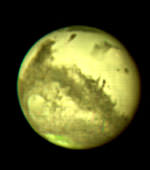
Image credit: UKIRT
Astronomers are searching for evidence of past water on Mars from the comfort of an observatory in Hawaii. They’re using the United Kingdom Infrared Telescope (UKIRT) to map the spectral signature given off of minerals on the Red Planet’s surface. They’re looking for minerals, such as hydrated clay, which would indicate the past presence of liquid water. NASA’s two Mars Exploration Rovers will be searching for similar signs on Mars when they arrive in January 2004.
As Mars makes its closest approach in almost 60,000 years, two Australian astronomers have used the United Kingdom Infrared Telescope (UKIRT) in Hawai`i to look for signs that the planet once had liquid water – and so may have hosted life.
Dr. Jeremy Bailey of the Anglo-Australian Observatory and the Australian Centre for Astrobiology (ACA) at Macquarie University in Sydney, and Sarah Chamberlain, a PhD student at the ACA, have produced what is Bailey says is “perhaps the sharpest image of Mars ever made from the ground.”
But the real gold lies in the spectral data they obtained.
The scientists are applying the same remote-sensing technique that geologists use to map minerals on the Earth’s surface.
Minerals absorb some wavelengths from sunshine and reflect others. Each mineral has its own ‘spectral signature’ – the set of wavelengths it reflects.
“We’re looking particularly for the signatures of minerals, such as hydrated clay minerals, that would indicate the past presence of liquid water,” said Bailey.
Similar prospecting by NASA’s Mars Odyssey spacecraft has shown that there is a vast amount of hydrogen below the surface of Mars. The consensus has been that this is probably water ice.
But did Mars ever have liquid water? And if so, how much? It’s still contentious.
NASA’s Mars Global Surveyor has found sizeable deposits of a mineral called crystalline (grey) hematite, which forms only in the presence of liquid water.
NASA’s two Mars Exploration Rovers, due to land on the Martian surface in January 2004, and the UK lander Beagle 2, due to land in December this year, will also be looking for signs that Mars has had liquid water.
“While spacecraft can get up close, ground-based observations still have a role, as they allow us to use larger and more powerful instruments,” said Bailey.
UKIRT, with a 3.8-m diameter aperture, is the world’s largest telescope devoted specifically to infrared observations.
UKIRT is funded by PPARC, the UK Particle Physics and Astronomy Research Council. The Anglo-Australian Observatory is funded by the UK Government, through PPARC, and the Australian Government.
Observations: Jeremy Bailey (Anglo-Australian Observatory and Australian Centre for Astrobiology, Macquarie University) and Sarah Chamberlain (Australian Centre for Astrobiology, Macquarie University). Data processing: Chris J. Davis, Joint Astronomy Centre, Hawai’i.
Original Source: Joint Astronomy Centre News Release
